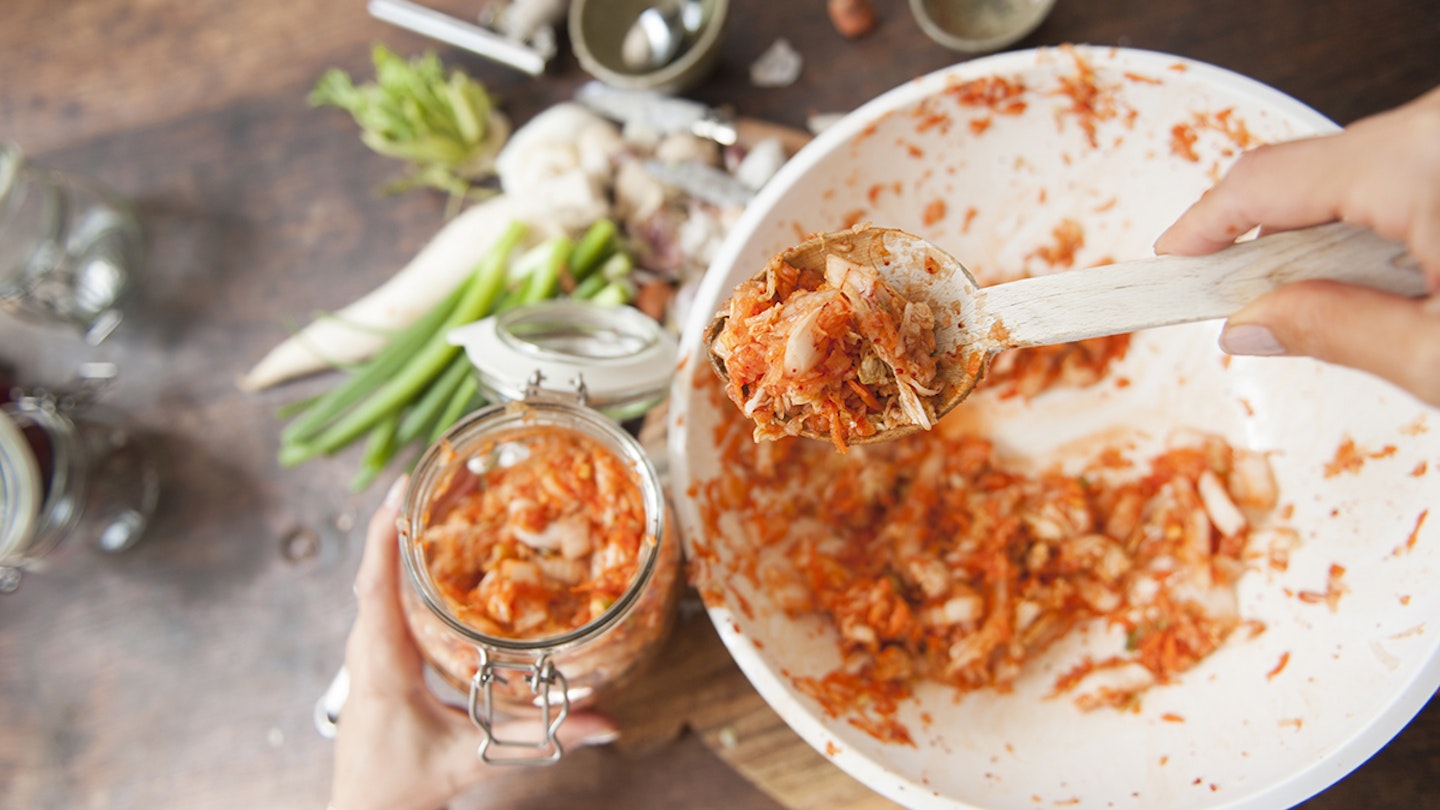Said to be in the top 5 healthiest condiments in the world, kimchi is a traditional Korean fermented vegetable pickle.
It is traditionally served with grilled meats or stir fried with rice but is becoming a very popular garnish/ingredient/condiment right here in the UK on everything; from a Cheeseburger to a burrito.
On salads and sandwiches it gives an amazing hit of warm sour chilli, garlic and ginger. Try a Grilled ‘Kimcheese’ sandwich: good sourdough, strong cheese and kimchi – heavenly!
With the added value of being raw and live – full of good bacteria, it is afermented food that is great for your gut health too.
Nick Vadasz, aka "The Pickle Man", is a pro when it comes to all things pickling. Here's his recipe for a traditional kimchi which is pure, natural and vegan without any dried shrimp or fish sauce or nasty sweetners/thickeners.
Ingredients
• 2 whole Chinese cabbage, (around 800g- 1kg each) – cored and cut into 4 lengthways and then chopped
• 1 kg carrots/mooli/or any radishes/root vegetables which you could eat raw – sliced thin
• 2 tbsp Natural Sea salt (ground) – or 2 small handfuls
• 3 tbsp - Korean Red pepper (course ground) – available from good Chinese/ oriental supermarkets
• 4 cloves of garlic
• 2 tbsp chopped fresh ginger – blended with water to form a thick paste
• 1 bunch long Spring onion – (use whole length) Chopped
You will need:
• 2 X Plastic buckets/containers, the same size, around 2lt (empty and washed ice cream tubs are ideal)
• 1 x large clean square washing up bowl or similar
• Food processor and knife
Method
- Wash Chinese cabbage pieces and mooli/carrot or other radishes, onions thoroughly and drain.
- Blend garlic, ginger, red pepper and water to make a paste.
- Salt the vegetables in a large bowl and toss – make sure to taste a bit, it should taste just a little too salty.
- Now add the red pepper paste – mix and massage well into the vegetables. Your cabbage/ veg/spice mix should be limp and brine should start appearing.
(It’s this brine that contains the sugars which naturally occurring yeasts will begin to work on creating an environment in which lacto bacillus will grow and help create the wonderful rich taste of fermented Kimchi.)
- Once the mix is limp and sponge like, pack it into 1 of your 2 containers.
- Push it down hard and compress – it needs to be submerged in brine in order to ferment efficiently.
- Now use your second container. Fill it with water, enough to keep the kimchi submerged and put a lid on it, and place on top of the pot you've filled with your Kimchi. This weight may need to be adjusted during the fermentation period, as the brine level increases. You may need to remove some volume/kimchi from the container in order to prevent too much brine escaping! (don’t waste the surplus - add to a stir fry!) You may also need to remove the water bucket/weight completely if your brine and kimchi are at the top of their container. Just cover with parchment/clingfilm/lid and loosen or ‘burp’ every few days to allow CO2 to escape.
- Carefully cover both containers in a muslin cloth or similar and place in a larger outer bowl to catch excess brine. Leave at room temperature for 10 – 28 days, tasting every week to check progress and to check brine is covering product.
- When it’s to your taste, it can be jarred and kept in the fridge for up to 3 months. Enjoy your Kimchi!
How long does kimchi need to ferment?
You can eat your kimchi after just a few days as it ferments quickly in warm temperatures. However, remember: Long & Slow is best! So store in the coolest part of your house/kitchen in summer and somewhere slightly warmer in the winter.
After around two weeks you should have a tasty kimchi – leave as long as you need to reach desired flavour – you decide.
You may get yeast growth and bubbles after a week or so on top – This is harmless part of the process and can be removed easily. What’s beneath is fine!
If you'd rather buy your kimchi, or want to taste test a pot before you make your own, here are some options available in the supermarket:
Just so you know, whilst we may receive a commission or other compensation from the links on this page, we never allow this to influence product selections.

www.sainsburys.co.uk
This versatile super condiment will elevate your sandwich, salad, burger - the possibilities are endless! Naturally fermented with live cultures for tasty healthy gutness. Suitable for vegetarians and vegans.

www.waitrose.com
A slightly different take on the traditional kimchi - this version is made with cucumber, apple and kale. Green jalapeu00f1o chilli gives it a bit of a kick too.
